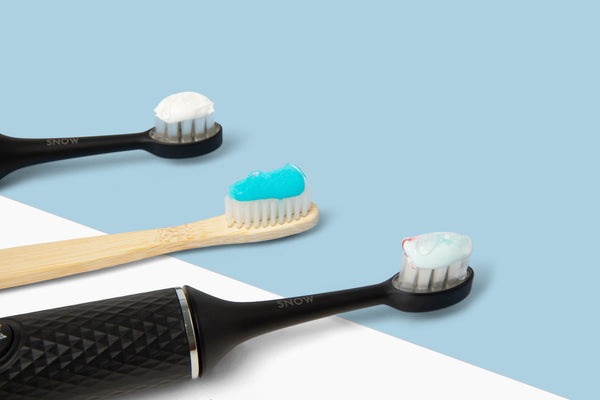With all the different types of toothbrushes available today, you'd be forgiven for asking, how are toothbrushes made? Toothbrushes are manufactured through a precise process involving injection molding, bristle insertion, quality checks, and packaging.
This article will delve into the intricacies of toothbrush production, addressing handle and bristle manufacturing, sustainability practices, and eco-friendly alternatives.
We aim to provide comprehensive insights into the toothbrush manufacturing industry, catering to individuals concerned about dental hygiene and environmental impact.
What this article covers:Manufacturing Process of a Toothbrush
At SNOW, we prioritize not only the effectiveness of our products but also their environmental impact.
Understanding the intricate process of toothbrush manufacturing sheds light on our commitment to eco-friendly practices.
According to MadeHow, toothbrushes undergo a series of steps to ensure quality and sustainability.
The parts of a toothbrush include the handle, head, and bristles, each playing a crucial role in oral health.
Let's take a look at the timeline of the toothbrush from start to finish.
Injection Molding Of Handles
The human race has come a long way since the first toothbrush ever was made.
Nowadays, plastic toothbrush handles start their journey through injection molding. Molten plastic is injected into a mold cavity, shaping the handles swiftly and efficiently.
This method minimizes waste and energy consumption, aligning with SNOW's eco-conscious ethos.
Bristle Insertion And Tufting
Following handle formation, bristles take center stage. Made of nylon filaments, these bristles are strategically tufted into the brush head to ensure optimal cleaning performance.
SNOW's dedication to precision and quality extends to bristle arrangement, promoting effective plaque removal while maintaining oral health.
Quality Control And Inspection
Quality control stands as a cornerstone of SNOW's manufacturing process.
Rigorous inspections, as highlighted by MadeHow, guarantee each toothbrush meets stringent safety and effectiveness standards.
From defect detection to durability testing, our commitment to excellence underscores every aspect of production.

Packaging And Distribution
Once toothbrushes pass quality assessments, they embark on their final journey: packaging and distribution. Tailored to meet diverse consumer preferences, packaging varies across brands and markets.
SNOW ensures eco-friendly packaging options whenever feasible, minimizing environmental impact while delivering quality oral care worldwide.
In essence, SNOW's dedication to eco-friendly toothbrush manufacturing transcends industry standards. By adhering to sustainable practices at every stage, we not only prioritize oral health but also advocate for a greener future.
Sustainability and Environmental Impact
At SNOW, sustainability is paramount in our commitment to reducing environmental impact. Toothbrush manufacturers are actively seeking eco-friendly alternatives to traditional plastic toothbrushes.
According to Blueland, eco-friendly toothbrushes utilize biodegradable materials like bamboo or recycled plastics, reducing waste and promoting sustainability. Exploring the types of electric toothbrushes can help consumers choose the best option for their oral health needs while being conscientious of the planet.
Our SNOW electric teeth whitening toothbrush epitomizes our dedication to eco-conscious oral care. Unlike disposable plastic toothbrushes, our electric toothbrush offers a long-term solution that minimizes plastic waste while providing effective teeth whitening.
With replaceable brush heads and sustainable materials, our toothbrush aligns with environmentally friendly practices, ensuring a brighter smile without compromising the planet's health.
The Dangers Of Plastic Toothbrushes
Plastic toothbrushes pose significant environmental challenges due to their composition and disposal methods.
According to National Geographic, many plastic toothbrushes are unrecyclable, primarily because they are made of composite plastics that are difficult, if not impossible, to break apart. As a result, these toothbrushes end up in landfills, contributing to pollution and harming ecosystems.
To address these issues, SNOW offers sustainable alternatives to traditional plastic toothbrushes. Our LED Teeth Whitening Electric Toothbrush, Bamboo Toothbrush, and Refillable Heads for LED Electric Toothbrush are designed to reduce plastic waste and promote eco-friendly oral care practices.
By choosing SNOW's products, individuals can embrace sustainability without compromising on oral health.
Make a positive impact on the environment while maintaining optimal oral hygiene by switching to SNOW's sustainable toothbrush options.
Conclusion
After delving into some of the many facts about toothbrushes we've compiled through our years of research, the intricacies of toothbrush materials, and the importance of sustainable oral care, it's evident that individuals can contribute to a greener environment while maintaining optimal oral hygiene.
From the durable handles made of polypropylene and polyethylene to the resilient nylon bristles, toothbrushes are designed with functionality and sustainability in mind.
Eco-friendly options like bamboo toothbrushes and recycled plastics offer consumers a chance to reduce plastic waste and make environmentally conscious decisions.
In a world where every choice matters, SNOW stands as a beacon of innovation and sustainability in teeth whitening. With our professional-grade teeth whitening kits, you can achieve dazzling results in the comfort of your own home.
Experience the transformative power of SNOW's teeth whitening solutions and unlock the radiant smile you deserve.
Did our blog meet your needs? You might also find our other guides helpful:
- How to Rehydrate Teeth After Whitening
- What to Do After Teeth Whitening
- Teeth Whitening Before Wedding
- What to Do Before Teeth Whitening
- Do Teeth Continue to Whiten After Treatment?
- Should I Get My Teeth Cleaned Before Whitening?
- Can I Use Mouthwash After Teeth Whitening?
- Can I Wear My Retainer After Teeth Whitening?
- Does Teeth Cleaning Whiten Teeth?
- Do Teeth Whitening Kits Work?
- Teeth Whitening Not Working
- Best Teeth Whitening Gel for Trays
- Does Saliva Ruin Teeth Whitening Gel
- What Happens If You Swallow Teeth Whitening Gel?
- Can You Put Teeth Whitening Gel in Your Retainer?




































































